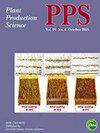Increasing lowland rice yields of smallholder farmers through the adoption of good agricultural practices in the forest agro-ecological zone of Ghana
IF 1.3
3区 农林科学
Q2 AGRONOMY
引用次数: 0
Abstract
ABSTRACT Rice is an important food crop in Ghana. However, its production has constantly been below 40% of the demand, and most of the requirements meet from imports. Such low production level is largely attributed to farmers’ sub-optimal crop and water management practices. As an effort toward sustainably improving rice yield, three-season on-farm participatory experiments were conducted within the Biem watershed in Ghana to determine the potential of good agricultural practices (GAP) for closing the rice yield gap with agronomic and economic sustainability. Good agricultural practices were compared with 23 farmers’ traditional practices on lowland rice growth and yield, profitability, and nutrient use efficiency. The effect of alternate wetting and drying (AWD) with GAP on grain yield of rice was also determined. Rice yield was on average 28% higher under GAP than farmers’ practices (FP). Alternate wetting and drying did not have significant effect on rice yield when compared to continuous flooding. However, when GAP was combined with AWD, rice yield was 13% higher than under FP. Furthermore, the results of the study indicate that major gains in nitrogen use efficiency (+1.48 kg grain kg−1 N; +2.4%), and net profit (+694.35 USD ha−1; +59%) were achievable through the adoption of GAP. There is therefore, a high potential to close the lowland rice yield gap and achieve rice self-sufficiency through the adoption of GAP in the lowlands of the Inland valley of Ghana and similar rice production regions of West Africa.通过在加纳的森林农业生态区采用良好的农业规范,提高小农的低地水稻产量
本文章由计算机程序翻译,如有差异,请以英文原文为准。
求助全文
约1分钟内获得全文
求助全文
来源期刊

Plant Production Science
农林科学-农艺学
CiteScore
5.10
自引率
4.00%
发文量
27
审稿时长
>36 weeks
期刊介绍:
Plant Production Science publishes original research reports on field crops and resource plants, their production and related subjects, covering a wide range of sciences; physiology, biotechnology, morphology, ecology, cropping system, production technology and post harvest management. Studies on plant production with special attention to resource management and the environment are also welcome. Field surveys on cropping or farming system are also accepted. Articles with a background in other research areas such as soil science, meteorology, biometry, product process and plant protection will be accepted as long as they are significantly related to plant production.
 求助内容:
求助内容: 应助结果提醒方式:
应助结果提醒方式:


